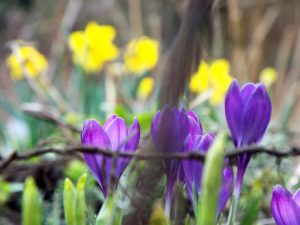 We are delighted that Camilla Lambrick of the Ashmolean Natural History Society is going to help us with our plant surveys this year. Camilla has written about a selection of spring flowers you can expect to find at Boundary Brook, and poetry inspired by them.
We are delighted that Camilla Lambrick of the Ashmolean Natural History Society is going to help us with our plant surveys this year. Camilla has written about a selection of spring flowers you can expect to find at Boundary Brook, and poetry inspired by them.
Which ones can you discover on your visits to the Nature Reserve?
Daisy
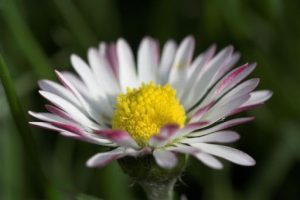 The name Daisy comes from Day’s eye because the flowers open by day and shut at night. The flowers are edible!! Daisy has a composite flower head; if you pull the flower head in half you will find short yellow florets in the middle and long florets round the outside which are white, sometimes with a touch of pink on the underside. To make a daisy chain use your fingernail to make a slit in one stem and poking the stem of the next flower through it.
The name Daisy comes from Day’s eye because the flowers open by day and shut at night. The flowers are edible!! Daisy has a composite flower head; if you pull the flower head in half you will find short yellow florets in the middle and long florets round the outside which are white, sometimes with a touch of pink on the underside. To make a daisy chain use your fingernail to make a slit in one stem and poking the stem of the next flower through it.
The Daisy Fairy by Cecily Mary Barker 1923
Come to me and play with me,
I’m the babies’ flower;
Make a necklace gay with me,
Spend the whole long day with me,
Till the sunset hour.
I must say Good-night, you know,
Till tomorrow’s playtime;
Close my petals tight, you know,
Shut the red and white, you know,
Sleeping till the daytime.
Dandelion
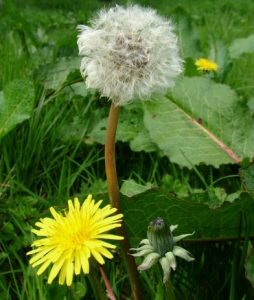 The name comes from the French dents de lion meaning teeth of a lion referring to the shape of the edges of the leaves. It also has a French name pis en lit (piss in the bed) from its diuretic effect. Like Daisies the flower heads are a tight mass of tiny florets each with tiny stamens and stigmas.
The name comes from the French dents de lion meaning teeth of a lion referring to the shape of the edges of the leaves. It also has a French name pis en lit (piss in the bed) from its diuretic effect. Like Daisies the flower heads are a tight mass of tiny florets each with tiny stamens and stigmas.
The Dandelion Fairy by Cecily Mary Barker 1923
Here’s the Dandelion’s rhyme:
See my leaves with tooth-like edges;
Blow my clocks to tell the time;
See me flaunting by the hedges,
In the meadow, in the lane,
Gay and naughty in the garden;
Pull me up—I grow again,
Asking neither leave nor pardon.
Sillies, what are you about
With your spades and hoes of iron?
You can never drive me out—
Me, the dauntless Dandelion!
Lesser Celandine
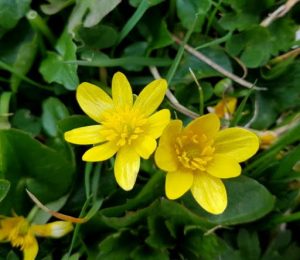 The name Celandine comes for the Greek Chelidon for a swallow, although the flowers come out long before the swallows arrive! Also called pilewort from the small tubers that resemble piles (little lumps around the anus). The flowers can predict weather as they close before rain. This is a member of the buttercup family.
The name Celandine comes for the Greek Chelidon for a swallow, although the flowers come out long before the swallows arrive! Also called pilewort from the small tubers that resemble piles (little lumps around the anus). The flowers can predict weather as they close before rain. This is a member of the buttercup family.
To the Small Celandine by William Wordsworth 1802/7
Pansies, lilies, kingcups, daisies,
Let them live upon their praises;
Long as there’s a sun that sets,
Primroses will have their glory,
Long as there are violets,
They will have a place in story:
There is a flower that shall be mine,
‘T is the little Celandine.
. . .
Comfort have thou of thy merit,
Kindly, unassuming Spirit !
Careless of thy neighbourhood,
Thou dost show thy pleasant face
On the moor and in the wood,
In the lane; — there’s not a place,
Howsoever mean it be,
But ‘t is good enough for thee.
Coltsfoot
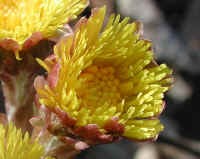 The flowers of this member of the Daisy family usually come out before the leaves. Both the stems and underside of the leaves are protected by woolly hairs. The leaves, which wither and die in early summer, are food plant for caterpillars several moth species.
The flowers of this member of the Daisy family usually come out before the leaves. Both the stems and underside of the leaves are protected by woolly hairs. The leaves, which wither and die in early summer, are food plant for caterpillars several moth species.
The Coltsfoot Fairy by Cecily Mary Barker 1923
The winds of March are keen and cold;
I fear them not, for I am bold.
I wait not for my leaves to grow;
They follow after: they are slow.
My yellow blooms are brave and bright;
I greet the Spring with all my might.
Bittercress
Like the cultivated cress and Watercress the leaves of this little cress are a tasty addition to any salad. Also called Lamb’s Cress and Hot Weed.
Bittercress is often a weed in flowerpots and can set seed only a month after germinating. The seed pods explode sending the sticky seeds up to a metre away.
Primrose
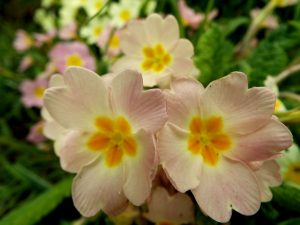 The name means the first rose, of spring! This is a woodland plant particularly abundant in the west. The flowers are of two types (heterostylous) – the pin flowers have the stigma visible like a small pin in the centre of the flower and the stamens are hidden near the base of the flower tube, while in thrum flowers the stigma cannot be seen and is found near the base of the flower, while the stamens are near the top. This means that pollen from the one type will mostly be delivered to the other thus promoting out crossing, which leads to more genetic diversity.
The name means the first rose, of spring! This is a woodland plant particularly abundant in the west. The flowers are of two types (heterostylous) – the pin flowers have the stigma visible like a small pin in the centre of the flower and the stamens are hidden near the base of the flower tube, while in thrum flowers the stigma cannot be seen and is found near the base of the flower, while the stamens are near the top. This means that pollen from the one type will mostly be delivered to the other thus promoting out crossing, which leads to more genetic diversity.
To a Primrose by John Clare 1820
Welcome, pale primrose, starting up between
Dead matted leaves of oak and ash, that strew
The every lawn, the wood, and spinney through,
‘Mid creeping moss and ivy’s darker green!
How much thy presence beautifies the ground!
How sweet thy modest, unaffected pride
Glows on the sunny bank and wood’s warm side!
And where thy fairy flowers in groups are found
The schoolboy roams enchantedly along,
Plucking the fairest with a rude delight,
While the meek shepherd stops his simple song,
To gaze a moment on the pleasing sight,
O’erjoyed to see the flowers that truly bring
The welcome news of sweet returning Spring.
Daffodil or Narcissus
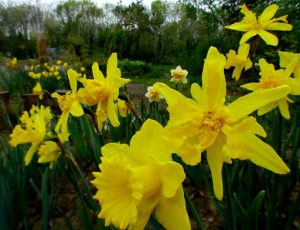 There are many different species and cultivars of daffodil. The wild one in Britain is pale yellow and smaller than many of the cultivated forms. In Greek mythology Narcissus was a youth who fell in love with his own reflection. The plant is poisonous and was formerly used medicinally.
There are many different species and cultivars of daffodil. The wild one in Britain is pale yellow and smaller than many of the cultivated forms. In Greek mythology Narcissus was a youth who fell in love with his own reflection. The plant is poisonous and was formerly used medicinally.
The Daffodil Fairy by Cecily Mary Barker 1923
I’m everyone’s darling: the blackbird and starling
Are shouting about me from blossoming boughs;
For I, the Lent Lily, the Daffy-down-dilly,
Have heard through the country the call to arouse.
The orchards are ringing with voices a-singing
The praise of my petticoat, praise of my gown;
The children are playing, and hark! they are saying
That Daffy-down-dilly is come up to town
Wood Anemone or Windflower
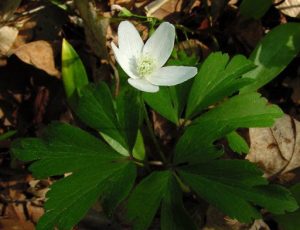 Anemone was a name used by Theophrastus the Father of Botany. There are many different species of anemone with vivid colours to be found in gardens; the woodland one is white, but on the chalk downs there is a purple one called the Pasque flower because it flowers at Easter.
Anemone was a name used by Theophrastus the Father of Botany. There are many different species of anemone with vivid colours to be found in gardens; the woodland one is white, but on the chalk downs there is a purple one called the Pasque flower because it flowers at Easter.
Revels the Moon did Light by Madison Julius Cawein 2012
I could not understand how these
Could hide so near to me,
When by the whispering of the trees
I knew the wood could see.
Until, all breathless with its joy,
The Wind, that could not rest,
Ran past me, like a romping boy,
And bade me look my best.
And there I saw them clasped in bliss
Beneath an old beech tree:
And – here’s the flower born of their kiss
This wild anemone.
The thorn-tree waved a bough of May
And all its branches bent
To indicate the wildwood way
The Wind and Sunbeam went. . . .
I knew its joy had filled with song
The high heart of the bird,
That rippled, rippled all day long
In dells that hushed and heard. . . .
All were in league to help me find,
Or tell to me the way,
Which now before me, now behind,
These two had gone in play.